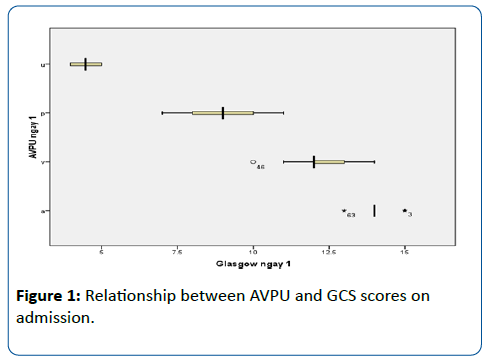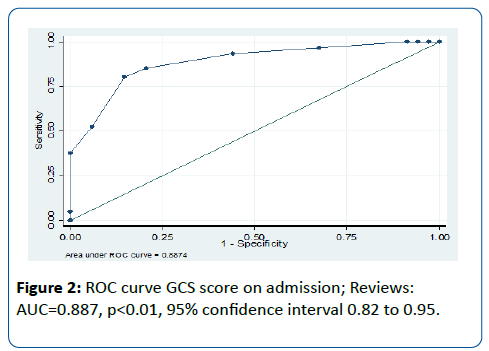Comparison of AVPU Scale and the Glasgow Coma Scale Score in Assessing Encephalitis in Children
Nguyen Thi Huyen Sam, Pham Ngoc Toan, Truong Thi Mai Hong and Le Thanh Hai
DOI10.21767/2573-0282.100029
Nguyen Thi Huyen Sam, Pham Ngoc Toan*, Truong Thi Mai Hong and Le Thanh Hai
Emergency Department, National Hospital of Pediatrics, Lathanh Street, Dongda District, Hanoi, Vietnam
- *Corresponding Author:
- Pham Ngoc Toan
Emergency Department, National Hospital of Pediatrics
Lathanh Street, Dongda District, Hanoi, Vietnam
Tel: +84904533068
E-mail: ngoctoancard@yahoo.com
Received date: October 13, 2016; Accepted date: October 26, 2016; Published date: October 31, 2016
Citation: Sam NTH, Toan PN, Hong TTM, Hai LT (2016) Comparison Of AVPU Scale And The Glasgow Coma Scale Score In Assessing Encephalitis In Children. Pediatric Infect Dis 1:29. doi: 10.21767/2573-0282.100029
Abstract
Vietnam is a developing country with tropical climate where infectious diseases, especially encephalitis are common. Every year, in National Hospital of Pediatrics from 200 to 300 encephalitis patients are hospitalized due to encephalitis. A rapid assessment of consciousness level in encephalitis is of importance in treatment and prognosis for patients. Two scales are usually used in assessment of consciousness level, The Alert Verbal Painful Unresponsiveness (AVPU) scale and the Glasgow Coma Scale (GCS). The GCS score is one of the most commonly used methods. AVPU scale is a simple method for assessment of consciousness. We conducted this study to determine how the AVPU responsive scale corresponds with the GCS in children who have encephalitis.
Keywords
Encephalitis; Children; Patients; Respiratory failure; Brain
Research Questions
1. To review assessment and used of the AVPU and the GCS in prognosis of encephalitis patients aged less than 2 years.
2. To find the relationship between AVPU, GCS score, clinical and subclinical indicators and treatment outcome.
Methods and Design
Subjects: Patients from 2 to 15 years old were diagnosed of encephalitis from 2/2014 to 8/2014.
Sample size: 95
Inclusion Criterion: Patients who had encephalitis (2-15 years of age).
Exclusion Criteria: Children with motor and mental retardation, and mental illnesses: epilepsy, brain tumors, and those were previously treated in local medical centers.
Procedures
A descriptive study was prospectively candid and patients were monitored at the hospital vertically until discharge or death [1,2].
The Alert Verbal Painful Unresponsiveness (AVPU) scale: A (Alert), V (responds to Voice); P (responds to Pain); U (Unresponsive); GCS (The Glasgow Coma Scale).
Eligible subjects: Informed and asked the consent and enrolment, Interviewed (caregivers) for risk factors (predictors); all subjects were tracked to discharge or end of life: All data were entered into Excel; and analyzed with STATA Version 13.1.
Analytic methods: Binary and ordered logistic regression.
Predictor variables: Age, sex, seizures, paralysis, respiratory failure, brain CT/MRI, microbiological etiology.
Outcome variables: AVPU and Glasgow score on admission to NHP.
Relation between AVPU, Glasgow, clinical and subclinical indicators and treatment outcome.
Results
95 patients were diagnosed of encephalitis in a 6 month study period.
Perception of patients according to AVPU, GCS scores on admission (Table 1, Figures 1 and 2).
| AVPU | Treatment outcome | P | OR (CI) | |
|---|---|---|---|---|
| Complete Recovery N |
sequelae, death N |
|||
| A(n=24) | 23 | 1 | ||
| V(n=32) | 27 | 5 | 0.22 | 4.3 (0.5-39.1) |
| P(n=37) | 11 | 26 | <0.01 | 54.4(9.3-145.9) |
| U(n=2) | 0 | 2 | <0.01 | |
Table 1: Relation between AVPU scores on admission and treatment outcome.
The relationship between AVPU, GCS score, clinical and subclinical indicators and treatment outcome (Tables 2,3 and 4).
| Related factors | Treatment outcomes | P | OR | ||
|---|---|---|---|---|---|
| Sequelae, death N |
Complete Recovery N |
||||
| GCS ≤ 10 | Seizures(n=30) | 24 | 6 | <0.01 | 53.3(12.2-233.2) |
| No (n=6) | 3 | 3 | 0.02 | 13.3(1.8-96.9) | |
| GCS > 10 | seizures (n=16) | 4 | 12 | 0.057 | 4.4(0.9-22.7) |
| No (n=43) | 3 | 40 | 1 | ||
| GCS ≤ 10 | paralysis (n=19) | 18 | 1 | <0.01 | 306(29.9-3132) |
| Normal (n=17) | 9 | 8 | <0.01 | 19.1(4.3-86.08) | |
| GCS > 10 | paralysis (n=5) | 4 | 1 | <0.01 | 68(5.7-813) |
| normal (n=54) | 3 | 51 | 1 | ||
| GCS ≤ 10 | respiratory failure (n=14) | 12 | 2 | <0.01 | 50(8.9-279.2) |
| respiratory normal (n=22) | 15 | 7 | <0.01 | 15.9(5.2-61.3) | |
| G > 10 | respiratory failure (n=3) | 1 | 2 | 0.32 | 4.2(0.3-53.1) |
| Respiratory normal (n=56) | 6 | 50 | - | 1 | |
Table 2: Relationship between GCS score, clinical indicators and treatment outcome
| Related factors | Treatment outcome | P | OR(95% CI) | ||
|---|---|---|---|---|---|
| Sequelae, death N | Complete Recovery N |
||||
| GCS ≤ 10 | CT abnormal (n=26) | 20 | 6 | <0.01 | 35.6(7.9-158.4) |
| CT Normal (n=10) | 7 | 3 | <0.01 | 24.9(4.1-150.1) | |
| GCS > 10 | CT abnormal (n=24) | 4 | 20 | 0.427 | 2.1(0.4-10.5) |
| CT Normal (n=35) | 3 | 32 | 1 | ||
| GCS ≤ 10 | Microbiology identified (n=21) | 15 | 6 | <0.01 | 43.8(7.9-242.1) |
| None identified (n=15) | 12 | 3 | <0.01 | 70(10.4-470.6) | |
| GCS > 10 | Microbiology identified (n=22) | 5 | 17 | 0.09 | 5.2(0.9-29.3) |
| None identified (n=37) | 2 | 35 | 1 | ||
Table 3: Relationship between GCS score, brain CT/MRI, microbiological etiology and treatment outcome.
| Related factors | OR | 95% CI | P univariate | P multivariate |
|---|---|---|---|---|
| 22.3 | 7.5-66.4 | < 0.01 | 0.023 | |
| P-U/AVPU | 21.2 | 7.1-63.5 | < 0.01 | 0.02 |
| Seizure | 11.2 | 3.4-31.5 | < 0.01 | 0.587 |
| Paralysis | 54.1 | 11.2-261.3 | < 0.01 | < 0.01 |
| Microbiology | 2.4 | 1.0-5.6 | < 0.05 | 0.62 |
| CT/MRI abnormal | 3.2 | 1.3-7.9 | < 0.01 | 0.91 |
| respiratory failure | 8.8 | 2.6-30.1 | < 0.01 | 0.015 |
| R=0.788; R2=62.1 | ||||
Table 4: Factors related encephalitis as multivariate regression analysis.
Discussion
Assessment of AVPU scale and GCS scale
The study show that the average score of AVPU scale and GCS scale are 14/12/9/4 (Figure 1 and Figure 2). Although AVPU has been used for many years, but research assessing the two scales is limited. A study of Mackey demonstrates similar results [3,4]. Kelly CA and there is no guiderline for the choice of AVPU or GSC [5].
Conciousness lever evaluated by glasgow scale
Figure 2 shows that patents with Glassgow scaler of fewer than 10 can have a higher risk of death and complications with a fairly high sensitivity (85.2%) and specificity (79.6%), with AUC of 0.887. A study of Bhutto E assessing patients with acute encepalitis by Glasgow demonstrates a score of less than 10 points accounting for 47.7% [6], which is similar to our results.
Analying multible variables
There is a relatioship between a glasgow score under 10 and convulsion with p<0.01. Patients who have Glasfow score under 10 and convulsion are more likely to have complicatins and die (Table 2). When glasgow score is under 10, the damage in the brain is more severe, and convulsion may makes the damage worse due to hypoxia and metabolic disfunction. Mirsa UK found that the lower the Glasgow score is, the more change of convulsion occures (71.8%) [7].
Glasgow score under 10 relates to paralyse. Patients who have less than 10 points of GCS and paralyse are 306 times more likely to be death or to have complications compare to the group without paralyse. When paralyse occures, there cohld be permernent damage in the brain tissues and it is difficult to recover.
Glasgow score less than 10 and respiratosy disstress. The risk of death and complications increases 50 times in the patients with glasgow under 10 and respiratosy disstress, and 19 times in the group glasgow score over 10 and respiratory disstress; and 4 time in the group with GCS over 10 without respitatory disstress. When patients have reduction of conciuousness levers and respiratory disstress (not because of respiratory diseases), the damage may develop in the center of respiratory.
In patients with Glasgow score under 10 and damage in the CT/MRI, the risk of complication and death increases 35 times compare to the group without damage in the CT/MRI and GCS over 10 (Table 3). Depending on the location of the damage in the CT/MRI as well as the severity, the complications and levers of conciousness are different. Small patients with encephalitis, cortex injury in the CT/MRI and low Glasgow should be treated with anti-epilepsy medication for a short period [7].
In patients with encephalytis due to JE, HSV, EV and Glasgow under 10, the risk of complications and death is the highest (Table 3). In our study, in most of the case, the cerebral spinal fluid is positive with JE. The damage is severe and the chance to a fully recovery is poor. The damage includes edema, buise, heamorrhage, necrotise, grey tissues. In the study, when analyzing multi-variables (convulsion, paralysis, respiratory distress, causes of encephalitis, damage in the CT/MRI, and Glasgow under 10), we find that only Glasgow and respiratory distress independently relates to outcomes of treatment. The relationship is statistically significant.
Conclusion
Our data would suggest that A/V/P/U corresponds with median GCS score of 14/12 /9/ 4, respectively. When patient’s AVPU score was V-P-U, the risk of sequelae and death was 34.7%. On admission if GCS score ≤ 10, the risk of sequelae and mortality were 85.2% sensitivity, 79.6% specificity. In term of prognosis Factors: GCS score ≤ 10 or AVPU score of P-U, paralysis and respiratory failure were independent factors related to treatment outcome.
References
- Simpson D, Reilly P (1982) “Pediatric coma scale”. lancet 2: 450.
- El-Amin EO, Elbashir MI, Elamin OE (2013) The underlying aetiologies of coma in febrile Sudanese children. Trans R Soc Trop Med Hyg 107: 307-12.
- Mackay CA, Burke DP, Burke JA (2000). Association between the assessment of consciouslevel using the AVPU system and the Glasgow coma scale. Pre-Hospital Immediate Care 4: 17-19.
- McNarry AF, Bateman DN ( 2004) Simple bedside assessment of level of consciousness: comparison of two simple assessment scales with the Glasgow Coma scale. Anaesthesia 59: 34-37.
- Kelly CA, Upex A, Bateman DN (2005) Comparison of consciousness level assessment in the poisoned patient using the alert/verbal/painful/unresponsive scale and the Glasgow Coma Scale. Ann Emerg Med 45: 108-13.
- Bhutto E, Naim M, Ehtesham M (1999) Prognostic indicators of childhood acute viral encephalitis. J Pak Med Assoc 49: 311-316.
- Misra UK, Kalita J (2009) Seizures in encephalitis: predictors and outcome. Seizure 18: 583-587.
Open Access Journals
- Aquaculture & Veterinary Science
- Chemistry & Chemical Sciences
- Clinical Sciences
- Engineering
- General Science
- Genetics & Molecular Biology
- Health Care & Nursing
- Immunology & Microbiology
- Materials Science
- Mathematics & Physics
- Medical Sciences
- Neurology & Psychiatry
- Oncology & Cancer Science
- Pharmaceutical Sciences


